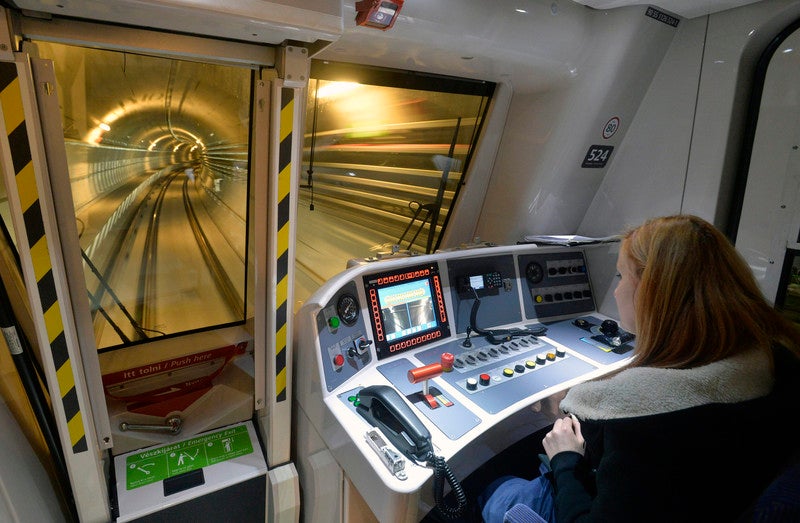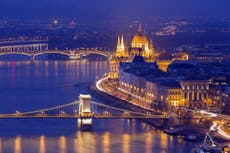Which is older, the London Underground or Budapest Metro?
Many in Budapest will tell you that their metro is the oldest in Europe, how true is that? It’s complicated. Mick O'Hare tells the story


Don that anorak and steel yourself for a heated debate. “It’s the oldest underground railway in the world.” That’s a statement you’ll sometimes hear from locals in Budapest talking about the city’s metro, which opened 125 years ago in 1896. Not so, say aficionados of the London Underground, it’s demonstrably untrue, ours predates it by 33 years. Yet still the story seems to persist, at least among Hungarians. It’s the oldest on the mainland continent of Europe for sure but even its electrification lagged six years behind the first electric line in London. Maybe it is just one of those myths from communist propaganda that has hung around. After all, the Great Soviet Encyclopedia insisted for decades that the first international football match was played by the USSR in 1930, ignoring the preceding 58 years of fixtures.
“No, no. It’s not that at all,” argues Zsombor Varga, a knowledgeable daily commuter who is passing through the system’s Astoria station. “It’s because Budapest was built solely as a metro, London wasn’t. The Metropolitan Line was just a railway that happened to run in tunnels at one end but branched out for many kilometres outside. Budapest was never a railway line, always a metro.” His countryman Gabor Molnár disagrees with his reasoning but still says Budapest was the first. “Ours was the first because it was wholly electric. In 1896 London still used steam on parts of the network,” (he’s right too but now we are arguing over what defines an underground railway). Is it all nitpicking? Presumably it depends on who is picking the nits.
We turn to Róbert Hradszki, the communications manager for the Budapest Metro’s Millennium Underground Museum, for the answer. “London,” he says. As if by deliberate contradiction a passing museum visitor answers in the affirmative when asked if Budapest is the oldest metro in the world. “I guess that maybe we just hope it is,” Hradski laughs.
It’s a tough one to referee, but fortunately it’s not a competition, despite the claims of the two nations’ trainspotters. Both have their history, and there is little doubt that the Budapest Metro is both venerable and significant. So significant in fact that in 2002 Unesco deemed a large section of the first line to be built, now called line M1 (but also redesignated by the city as the Millennium Underground Railway), to be a world heritage site, citing it as an example of “the implementation of planning solutions associated with the latest technical facilities of the day to meet the requirements of an emerging modern society”. The Institute of Electrical and Electronics Engineers bestowed it with further accolades, deeming it “a ‘Milestone’ development, with its innovative bidirectional tram cars, electric lighting in the stations and overhead wires”.
At the end of the 19th century the nation was looking forward to celebrating the 1,000th anniversary of the Hungarian Conquest in the Carpathian Basin and were expecting many visitors to Budapest. For this millennium new buildings and sights were being commissioned, including Heroes’ Square and city planners wanted tourists to be able to appreciate the imperial monuments but without “any unpleasing visual blight”. Or, more bluntly, the Budapest authorities wanted a tram line linking all their grand buildings but didn’t want the trams actually spoiling the view. So they hid them underground (which also opens up another can of worms. If it was a tram tunnel, it can’t be the oldest underground railway, but conversely it can claim to be Europe’s oldest tram tunnel, predating the Kingsway tunnel in Holborn by 10 years. Anorak politics was never so complex…)
Today the fabled yellow carriages of the M1 line rattle along only a couple of metres beneath Andrássy Avenue – Budapest’s longest – also part of the Unesco listing. The line has run continuously between Vörösmarty tér (then known as Gizella tér) in the city centre and Széchenyi fürdõ (then known as Artézi fürdõ) since 1896, and now extends further. Known as the Földalatti (Hungarian for underground railway), by modern standards it’s all rather dinky, exposing its tram-based origins. “The reason it is so close to the surface,” explains Hradszki, “is because Budapest’s original main sewer ran right underneath. For obvious reasons they wanted to avoid having to move it.”
The M1 line is a mere 4.4 kilometres long even today and the tunnels are only six metres wide and three high. Its tiled station interiors, restored for its centenary in 1996, have classical columns supporting the road above. Originally the station entrances were designed with splendidly ornate secession-style pavilions although these were removed between the two world wars, and during the years of communist rule many of the stations were modified along utilitarian socialist principles. However, for the railway’s centenary Vörösmarty tér was rebuilt in the original style.
The stations are also named after some of Budapest’s most famous sights and monuments as the line runs away from the Danube on the Pest side of the city. “Budapest was beginning to consider itself as a world-leading metropolis,” says Hradszki, “and it was vanity which eventually persuaded the city authorities to build the railway.” Budapest, as all Hungarian schoolchildren are taught, is actually two towns, Buda and Pest, one on either side of the river, which merged in 1873 to form a city. And modern cities needed public transport, the most fashionable form of which – in 1896 – was a metro.
“The line paid for itself too,” says Hradzski, “unlike a lot of modern infrastructure projects.” In fact it envisaged 35,000 travellers a day but (pre-Covid) it now sees more than 100,000 so you’ll need to brave the crowding (post-Covid) to catch the Unesco sights. Hop off before the klaxon sounds to indicate the slamming doors and you can spend the afternoon soaking up the sights, or indeed soaking in the thermal springs for which Budapest is famous, because the original northeastern end of the line is Széchenyi fürdõ station, home to the baths of the same name. Built in 1913 it is the largest thermal bath in a city that has many to choose from. One stop south is Hősök tere – the aforementioned Heroes’ Square – a monument to significant individuals in Hungarian history and surrounded by art galleries. Further along the line you’ll encounter the Opera, St Stephen’s Basilica (Stephen was the monarch who established the Hungarian state) and the end of the line at Vörösmarty tér, in the heart of old Pest where it meets the Danube.
The line has carried royalty including Austro-Hungarian emperor Franz Josef, who rather graciously allowed the railway to be named after him, and German Kaiser Wilhelm II. Obviously, following the defeat of Germany and Austro-Hungary in the First World War there was limited opportunity for monarchical recognition thereafter and line M2, while taking many years in the planning, would eventually be built by Hungary’s postwar communist rulers, although they took their time. Work began in the 1950s but the first services didn’t run until 1970 (pity line M5 proposed decades ago and still merely a glint in the city planning department’s eye). M2 is a far more utilitarian affair, intended not to show off an imperial city’s grandiose architecture but to be of practical use to the city’s workers, linking Budapest’s main railway stations and housing estates. But despite their supposed egalitarian principles, the country’s politicians also built themselves an escape route in the event of the nuclear war that was so frequently predicted during the Cold War years. Between Kossuth tér and Deák Ferenc tér stations is a 3,500-square-metre bunker with a direct tunnel to the Hungarian parliament. While the city above them burned the government would flee to the shelter before escaping the capital by armoured train. It’s still there although access on infrequent tours is limited.
Line M2 was the first to tunnel beneath the Danube (although line M4 now also is) to allow passengers from the Buda side of the city to travel to Pest by train. “It also had lifts,” points out Hradzski, “unlike M1, because it was much deeper.” He admits that the London Underground had lifts long before Budapest (1890 since you ask). The tunnelling required to build the line reputedly damaged the Hungarian National Theatre so badly that it was eventually demolished and rebuilt elsewhere.
On the Buda side M2 intersects with the huge transport hub at Széll Kálmán tér, a public transport aficionado’s heaven (whether you’re from Budapest or London). Metro meets trams, meets buses, meets trolley buses and they are all a short hop from Budapest’s cog-wheel railway which carries passengers up a steep incline into the Buda Hills where you’ll find the Budapest Children’s Railway, a leftover from the communist era when it was known as the Pioneer Railway. It’s staffed entirely by children (with adult supervision) originally training them for careers on the Hungarian state railway. It runs for 11 kilometres through the forest. On your way from Moszkva tér to the cog-wheel railway you’ll likely pass the cylindrical Danubius Budapest, formerly known as the Budapest Hotel. During the Cold War visiting western diplomats enjoyed its hospitality but it was considered so heavily bugged that it’s said every subversive capitalist imperialist sex act in each of its 289 rooms could be heard in the Kremlin.
M2 was beset with delays, not least when construction was seemingly permanently halted following the Soviet Union’s invasion of Hungary in 1956. Maybe out of feelings of guilt the Soviet Union supplied some of the trains (the builders of which went by the rather splendid name of Metrowagonmash) that would run on the line when it finally opened.
Line M3’s claim to fame is that it featured in possibly the most famous cult movie shot in Hungary. In Kontroll, supposedly set half a century after the line opened in 1976, the stations and tunnels are hauntingly shot as a surreal underground world is invoked. London’s underground definitely loses out to the award-winning film – have you ever seen Death Line, a horror movie set on the London tube? “Mind the gap” is the cry of the cannibalistic being who lives in the closed-down British Museum station on the Central Line. It’s truly dreadful, despite its moth-to-a-flame qualities.
In stark contrast to line M2, M3 took a mere six years to build and is the longest of the metro lines at a tad over 17 kilometres. “It’s also the busiest,” adds Hradzski. If you like your Soviet era tech, occasionally you might spot an original Russian-built carriage on line M3. “They have been renovated but they are still the originals,” says Hradzski. Sadly for Cold War nostalgics, the last to run on M2 did so in April 2013, but it’s certainly durable stuff because similar rolling stock was to be found in all of the capital cities of the former eastern bloc right up until the last decade.
Of course, this history is all celebrated in Hradzski’s tiny museum on the concourse at Deák Ferenc tér station, the main interchange on the system (only line M4 doesn’t stop there), where you can spy some of the original carriages from the railway’s early years. It’s inside a disused section of tunnel closed in 1955 and as visitors move between the exhibits they pass one of the original tiled signs for Gizella tér station opened in 1896, ambitious plans for the system drawn up down the intervening decades and ephemeral bric-a-brac from tickets to signals to uniforms. “We have the lead engineer’s original journal,” says Hradzski. “Ödön Vojtek recorded every stage of the process when he was building the first line.” He did indeed, alongside documentation which reveals that the original name of M1 was the Budapest Underground Electric Tramway. Hmmm, that’s best passed quickly over for those who insist it was a railway and therefore beat London. “He was a bit of a stickler for detail,” says Hradzski. “The original M1 was always considered to be 3.7 kilometres long. But we discovered from his notes that it was actually 3,688 metres and 76 centimetres.” The 76 centimetres obviously meant a lot to him.
But beyond all the history (and historical inter-city wrangling) and the imperialist splendour-turned-communist utilitarianism of lines 1 to 3, the Budapest Metro does have one nailed-on first. Line M4 is Europe’s first fully automatic metro line, with no drivers or operators required to travel on the trains. (“It’s not,” argues commuter and tube fan Paul Allenby, clearly the yang to Zsombor Varga’s ying, as he passes through London Underground’s Green Park station. “The Victoria Line had driverless trains and it was built in 1968.”) Maybe we need to call in VAR – it seems the rivalry between the two will never cease, but in this case the Victoria Line is going to lose out. Its trains might have been automatic but they still needed a human in the cab to operate the doors and ensure safety like many other so-called automatic systems around the world, including Budapest’s line M3. M4 has no humans on board controlling it at all “except if a train is unable to move because of breakdown or another reason,” says Hradzski.
Opened in 2014 and built by Siemens, who were the contractors for the original line back in 1896, it was intended that it would mimic the flamboyant Moscow Metro system but in 1990 – a year after Hungary threw off Soviet rule – the incoming mayor of Budapest Gábor Demszky promised to ditch any Russian-backed infrastructure projects. Suddenly M4 was based on the French Metro – anything Russian was deemed persona non grata. It’s a surprise to see the driver’s cab empty when you climb aboard one of the trains departing the terminus at Keleti mainline station, you sometimes find yourself pulling on an imaginary brake as you arrive at each stop. Forget that it took 40 years from proposal to completion and was riven with allegations of fraud and corruption, and marvel at the cavernous and gleaming modern stations, supported by huge cross-beams. It’s all terribly modern and the antithesis of M1 – although that is equally splendid in its own right. And while some of the capital’s residents complain that it runs from nowhere to nowhere stopping at nowhere in particular via nowhere, it at least looks impressive. And did we mention those driverless trains that you can’t find on the London Underground? We did, didn’t we?
Anna Takács, a commuter at Deák Ferenc tér and on her way to a literature festival on Gellert Hill, has an esoteric take on Budapest’s underground and other metros. “They are the vascular system of the city,” she posits. “Without them the city chokes. Budapest’s is much more than a railway, it is a celebration of who were are – just look at the map of the network. The stations mark the monuments, the monuments are the history of a nation. It brings coherence to the city, you understand where everything is in relation to everything else. I know people who cannot find their way through the streets of Budapest but can use the Metro, which does it for them. Budapest, London, New York, Paris, Moscow – all defined by their underground railways. The cities can no longer survive without them.” Even in this post-Covid world, she is almost certainly correct.
One imagines Takács doesn’t care about the endless London or Budapest arguments. She’s clearly seen beyond that. First, most electric, most driverless, oldest, longest…? At fewer than 40km in total, Budapest’s track length is dwarfed by London’s 402. But let’s quit the bickering because in any case both lose out handsomely to Beijing’s 690km of track. For that matter, New York has the most stations with 424. And Beijing tops the highest number of users per year at a whopping 3.8 billion. So stop the feuding, London and Budapest. Be proud of what you’ve got!




Join our commenting forum
Join thought-provoking conversations, follow other Independent readers and see their replies
Comments